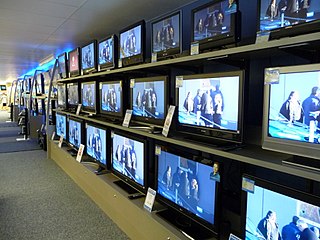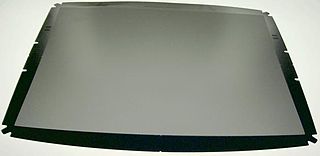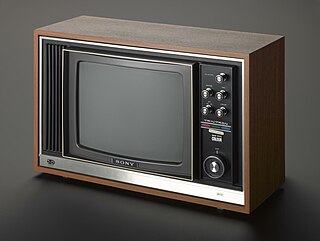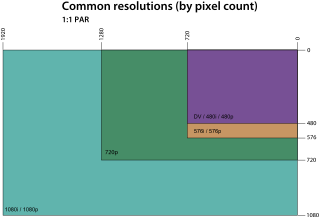
A cathode-ray tube (CRT) is a vacuum tube containing one or more electron guns, which emit electron beams that are manipulated to display images on a phosphorescent screen. The images may represent electrical waveforms on an oscilloscope, a frame of video on an analog television set (TV), digital raster graphics on a computer monitor, or other phenomena like radar targets. A CRT in a TV is commonly called a picture tube. CRTs have also been used as memory devices, in which case the screen is not intended to be visible to an observer. The term cathode ray was used to describe electron beams when they were first discovered, before it was understood that what was emitted from the cathode was a beam of electrons.

A computer monitor is an output device that displays information in pictorial or textual form. A discrete monitor comprises a visual display, support electronics, power supply, housing, electrical connectors, and external user controls.

Television (TV) is a telecommunication medium for transmitting moving images and sound. The term can refer to a television set, or the medium of television transmission. Television is a mass medium for advertising, entertainment, news, and sports.

An aperture grille is one of two major technologies used to manufacture color cathode-ray tube (CRT) televisions and computer displays; the other is the shadow mask. The first patented aperture grille televisions were manufactured under the Trinitron brand name.

The shadow mask is one of the two technologies used in the manufacture of cathode-ray tube (CRT) televisions and computer monitors which produce clear, focused color images. The other approach is the aperture grille, better known by its trade name, Trinitron. All early color televisions and the majority of CRT computer monitors used shadow mask technology. Both of these technologies are largely obsolete, having been increasingly replaced since the 1990s by the liquid-crystal display (LCD).

Trinitron was Sony's brand name for its line of aperture-grille-based CRTs used in television sets and computer monitors, one of the first television systems to enter the market since the 1950s. Constant improvement in the basic technology and attention to overall quality allowed Sony to charge a premium for Trinitron devices into the 1990s.
Apple Inc. has sold a variety of LCD and CRT computer displays since introducing their first display in 1980. Apple paused production of their own standalone displays in 2016 and partnered with LG to design displays for Macs. In June 2019, the Pro Display XDR was introduced, however it was expensive and targeted for professionals. In March 2022, the Studio Display was launched as a consumer-targeted counterpart. These are currently the only Apple-branded displays available.

The display resolution or display modes of a digital television, computer monitor or display device is the number of distinct pixels in each dimension that can be displayed. It can be an ambiguous term especially as the displayed resolution is controlled by different factors in cathode ray tube (CRT) displays, flat-panel displays and projection displays using fixed picture-element (pixel) arrays.
1080i is a combination of frame resolution and scan type. 1080i is used in high-definition television (HDTV) and high-definition video. The number "1080" refers to the number of horizontal lines on the screen. The "i" is an abbreviation for "interlaced"; this indicates that only the even lines of each frame, then only the odd lines, are drawn alternately, so that only half the number of lines are ever updated at once. A related display resolution is 1080p, which also has 1080 lines of resolution; the "p" refers to progressive scan, which indicates that each full frame appears on the screen in sequence.

WEGA was a German audio and video manufacturer, manufacturing some of Germany's earliest radio receivers.

A CRT projector is a video projector that uses a small, high-brightness cathode ray tube (CRT) as the image generating element. The image is then focused and enlarged onto a screen using a lens kept in front of the CRT face. The first color CRT projectors came out in the early 1950s. Most modern CRT projectors are color and have three separate CRTs, and their own lenses to achieve color images. The red, green and blue portions of the incoming video signal are processed and sent to the respective CRTs whose images are focused by their lenses to achieve the overall picture on the screen. Various designs have made it to production, including the "direct" CRT-lens design, and the Schmidt CRT, which employed a phosphor screen that illuminates a perforated spherical mirror, all within an evacuated cathode ray tube.
Cromaclear is a trademark for CRT technology used by NEC during the mid to late-90s. This adopted the slotted shadow mask and in-line electron gun pioneered by the 1966 GE Porta-Color and used by most then-current television tubes to computer monitor use. It was claimed that Cromaclear could offer the image clarity and sharpness of the Trinitron and Diamondtron aperture grille CRTs without the disadvantages e.g. expense and the horizontal damping wires.
XBR is a line of LCD, OLED, Plasma, Rear Projection, and CRT televisions produced by Sony. According to Sony, XBR is an acronym for eXtended Bit Rate, although there is evidence that it originally stood for "Project X, Black Remote" which was supposed to set it apart from the then-standard line of Sony televisions. The XBR range is typically derived from equipment that has been released in Japan and Europe as mid and high-end models, usually with some small upgrades. For example, in Europe and Japan, the Sony X-Series 1080p TVs had two HDMI inputs, whereas on the American XBR version, there were three. Some XBR televisions may cost up to $25,000 USD.

Large-screen television technology developed rapidly in the late 1990s and 2000s. Prior to the development of thin-screen technologies, rear-projection television was standard for larger displays, and jumbotron, a non-projection video display technology, was used at stadiums and concerts. Various thin-screen technologies are being developed, but only liquid crystal display (LCD), plasma display (PDP) and Digital Light Processing (DLP) have been publicly released. Recent technologies like organic light-emitting diode (OLED) as well as not-yet-released technologies like surface-conduction electron-emitter display (SED) or field emission display (FED) are in development to supercede earlier flat-screen technologies in picture quality.

The XEL-1 is the world's first organic light-emitting diode (OLED) television, designed by Sony in 2007 and produced for sale the following year. It was also the world's thinnest television during its production, at 3 mm. It has a screen size of 11 inches with a native resolution 960×540. The top of the base has 2 speakers and the power, volume, channel, input, and menu buttons, which are backlit, so the symbols and abbreviations change when the XMB interface is accessed. The back of the panel has a DMeX service input, a 16-volt DC input, a VHF/UHF/cable input, a Memory Stick slot, and two HDMI inputs. On the left side of the panel there is an analog/digital audio output.
The Chromatron is a color television cathode ray tube design invented by Nobel prize-winner Ernest Lawrence and developed commercially by Paramount Pictures, Sony, Litton Industries and others. The Chromatron offered brighter images than conventional color television systems using a shadow mask, but a host of development problems kept it from being widely used in spite of years of development. Sony eventually abandoned it in favor of their famous Trinitron system using an aperture grille.
The beam-index tube is a color television cathode ray tube (CRT) design, using phosphor stripes and active-feedback timing, rather than phosphor dots and a beam-shadowing mask as developed by RCA. Beam indexing offered much brighter pictures than shadow-mask CRTs, reducing power consumption, and as they used a single electron gun rather than three, they were easier to build and required no alignment adjustments.

The graphics display resolution is the width and height dimension of an electronic visual display device, measured in pixels. This information is used for electronic devices such as a computer monitor. Certain combinations of width and height are standardized and typically given a name and an initialism which is descriptive of its dimensions. A graphics display resolution can be used in tandem with the size of the graphics display to calculate pixel density. An increase in the pixel density often correlates with a decrease in the size of individual pixels on a display.

Ultrawide formats refers to photos, videos, and displays with aspect ratios greater than 2. There were multiple moves in history towards wider formats, including one by Disney, with some of them being more successful than others.













